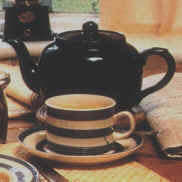The GBK CookbookApplied Ability AwardsThe British Food TrustOther |
The Good Old British Cuppaby Marion WatsonThank God for tea!
The British love their tea. It is the great panacea, a cure for all ills. How often in a play, when someone is suffering from a great tragedy does a friend or neighbour say "What you need is a nice cup of tea! Then you’ll feel much better." Originally from China the British went to extraordinary lengths to develop plantations within the Empire, especially in India, Ceylon (as Sri Lanka was then called), Kenya and Malaya. Tea likes a cool climate, sunshine and light rain. Whole mountainsides were carved into terraces for planting bushes. Roads had to be made to get the tea off the plantations and railways engineered over the most difficult terrain. Tea was first planted commercially in Sri Lanka in 1867 and the railway from Kandy going nearly up to the hill station of Newara Eliya and on to the terminus at Badulla is a death-defying series of steep gradients as the train hauls itself up out of valleys and back down again, clinging to the mountainside. Leaving from Colombo it climbs steadily then begins to twist and turn through high passes to reach Kandy. After that the gradient gets even steeper as it approaches the mountains covered in tea plantations. The gradient becomes so steep that if the Swiss had built it they would have made it a rack railway, but not the British, they just used an extra engine to push from behind. In some parts of the world it would have been a narrow gauge to cope with the twists and turns but the British chose to build broad gauge through this difficult country; and all to get the tea out.
Nurara Elija is surrounded by tea plantations, reaching up to the mountain tops with horizontal paths between each row of bushes and vertical ones at regular intervals. When the shrubs get too big they are cut back and allowed to shoot again. Trunks at the base are often very old and gnarled. Only occasionally do you see a patch which has been re-planted. Tamil labour was brought in from India in the last century to work the plantations which in more recent times has led to much of Sri Lanka’s political difficulties. Once the lives of the tea workers was a very hard one with poor housing and very low rates of pay although much is being done now to improve their lot. Only the top three leaves or two leaves and a bud are picked. The pluckers, as they are called, pick them with their fingertips before transferring them to the bags, or baskets, on their backs. They carry a long cane which they lay across the bushes so that they are picked evenly. This gives the characteristic flat top to the shrubs along the terraces. Bushes have to be picked every twenty days. But a lot has to happen to the tea leaves from the time they are plucked until they reach our teapot.
The tea is packed in chests which, together with samples, is sent to Colombo for auction. Until now further auctions have taken place in London. Tea is only packaged when it has been auctioned and reached its country of destination. Flavourings such as the bergamot in Earl Grey are added before this final packaging. And so it finally reaches the shops and our homes and teapots. William Gladstone said: If you are cold, tea will warm you. If you are too heated, it will cool you. If you are depressed it will cheer you. If you are excited, it will calm you.
Some people leave the remains of the teapot contents to cool and us it to water their houseplants. Camellias (a member of the tea family) are said to be very partial to a mulching of tealeaves round their roots in the garden. And some people have been known to use cooled teabags as refreshing packs for tired eyes. Then, if you use loose-leaf tea when the cup is empty you can invert it over the sauce and use the resulting pattern to tell your fortune. Of course, not everyone approved of this beverage. Jessey Torrey in The Moral Instructor , 1819,said: Tea possesses an acid astringent quality, peculiar to most leaves and exterior bark of trees, and corrodes and paralyses the nerves. But, to some, tea is worth its weight in gold and the enormous efforts made to produce and export it proves how very popular it was, and still is, although perhaps not everyone would go as far as Colley Cibber in The Lady’s Last Stake who said: Tea! thou soft, thou sober, sage and venerable liquid, thou female tongue-running, smile-soothing, heart-opening, wink-tippling cordial to whose glorious insipidity I owe the happiest moments of my life, let me fall prostrate. |
||


 Top of page
Top of page
 Previous page
Previous page